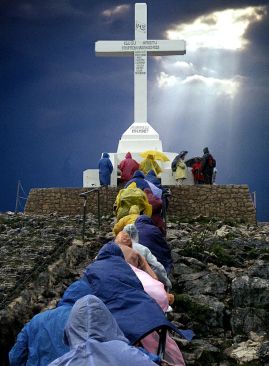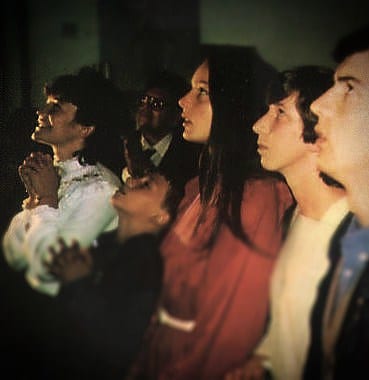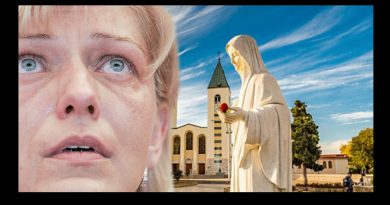MEDJUGORJE… WHAT YOU MAY NOT KNOW
Follow Mystic Post on Facebook
The six seers of Medjugorje when they were children

…bear fruits by which the Church herself might later discern the true nature of the facts…—”Norms Regarding the Manner of Proceeding in the Discernment of Presumed Apparitions or Revelations” n. 2, vatican.va
Dear children, my real, living presence among you should make you happy because this is the great love of my Son. He is sending me among you so that, with a motherly love, I may grant you safety! —Our Lady of Medjugorje to Mirjana, July 2, 2016
STRANGE TWISTS…
No one has forced them or influenced them in any manner. These are six normal children; they are not lying; they express themselves from the depth of their hearts. Are we dealing here with a personal vision or a supernatural occurrence? It is hard to say. However, it is certain that they are not lying. —statement to the press, July 25, 1981; “Medjugorje Deception or Miracle?”; ewtn.com
I have not seen more normal children. It is the people who brought you here who should be declared insane! —Medjugorje, The First Days, James Mulligan, Ch. 8
 the seers to a battery of testswhile they were in ecstasy during apparitions—from poking and prodding, to blasting them with noise and monitoring brain patterns—Dr. Henri Joyeux and his team of doctors from France concluded:
the seers to a battery of testswhile they were in ecstasy during apparitions—from poking and prodding, to blasting them with noise and monitoring brain patterns—Dr. Henri Joyeux and his team of doctors from France concluded:The ecstasies are not pathological, nor is there any element of deceit. No scientific discipline seems able to describe these phenomena. The apparitions at Medjugorje cannot be explained scientifically. In one word, these young people are healthy, and there is no sign of epilepsy, nor is it a sleep, dream, or trance state. It is neither a case of pathological hallucination nor hallucination in the hearing or sight facilities…. —8:201-204; “Science Tests the Visionaries”, cf. divinemysteries.info
 ecstasy and sent the results to Pope Benedict XIV.
ecstasy and sent the results to Pope Benedict XIV.After twenty years, our conclusion has not changed. We were not wrong. Our scientific conclusion is clear: the Medjugorje events must be taken seriously. —Dr. Henri Joyeux, Međugorje Tribune, January 2007
…for reasons still not entirely clear, Bishop Zanic almost immediately changed his attitude, becoming the main critic and opponent of the Medjugorje apparitions. — “Medjugorje Deception or Miracle?”; ewtn.com
 Perhaps for one or all of the reasons above, Bishop Zanic rejected the results of his first Commission and went on to form a new Commission to investigate the apparitions. But now, it was stacked with skeptics.
Perhaps for one or all of the reasons above, Bishop Zanic rejected the results of his first Commission and went on to form a new Commission to investigate the apparitions. But now, it was stacked with skeptics.Nine of the 14 members of the second (larger) commission were chosen among certain theologians who were known to be skeptical concerning supernatural events. —Antonio Gaspari, “Medjugorje Deception or Miracle?”; ewtn.com
During the inquiry these events under investigation have appeared to go much beyond the limits of the diocese. Therefore, on the basis of the said regulations, it became fitting to continue the work at the level of the Bishops’ Conference, and thus to form a new Commission for that purpose. —appeared on the front page of Glas Koncila, January 18, 1987; ewtn.com
On the basis of the investigations so far, it cannot be affirmed that one is dealing with supernatural apparitions and revelations. —cf. Letter to Bishop Gilbert Aubry from the Secretary for the Congregation for the Doctrine of the Faith, Archbishop Tarcisio Bertone; ewtn.com
 “so far”, a firm conclusion on the supernatural nature cannot be affirmed. It is not a condemnation but a suspension of judgment.
“so far”, a firm conclusion on the supernatural nature cannot be affirmed. It is not a condemnation but a suspension of judgment.Cardinal Franjo Kuharic, Archbishop of Zaghreb and President of the Yugoslav Bishops’ Conference, in an interview with Croatian public television on December 23, 1990, said that the Yugoslav Bishops’ Conference, including himself, “has a positive opinion of Medjugorje events.”—cf. Antonio Gaspari, “Medjugorje Deception or Miracle?”; ewtn.com
 refused to budge from his own verdict, had impeded a positive decision on the Medjugorje apparitions. [7]
refused to budge from his own verdict, had impeded a positive decision on the Medjugorje apparitions. [7]The bishops used this ambiguous sentence (non constat de supernaturalitate) because they did not want to humiliate Bishop Pavao Zanic of Mostar who constantly claimed that Our Lady did not appear to the seers. When the Yugoslav Bishops discussed the Medjugorje issue, they told Bishop Zanic that the Church was not giving a final decision on Medjugorje and consequently his opposition was without any foundation. Hearing this, Bishop Zanic began to cry and to shout, and the rest of the bishops then quit any further discussion. —Archbishop Frane Franic in January 6, 1991 issue of Slobodna Dalmacija; cited in “Catholic Media Spreading Fake News on Medjugorje”, March 9th, 2017; patheos.com
I believe what I am required to believe—that is the dogma of the Immaculate Conception which was issued four years before Bernadette’s alleged apparitions. —witnessed in a sworn statement attested to by Fr. John Chisholm and Major General (ret.) Liam Prendergast; the remarks were also published in the February 1, 2001, European newspaper, “The Universe”; cf. patheos.com
 keep the pilgrimage site open to the faithful and any negative declaration from gaining traction. In a letter of clarification to Bishop Gilbert Aubry, Archbishop Tarcisio Bertone of the Congregation for the Doctrine of the Faith wrote:
keep the pilgrimage site open to the faithful and any negative declaration from gaining traction. In a letter of clarification to Bishop Gilbert Aubry, Archbishop Tarcisio Bertone of the Congregation for the Doctrine of the Faith wrote:What Bishop Peric said in his letter to the Secretary General of “Famille Chretienne”, declaring: “My conviction and my position is not only ‘non constat de supernaturalitate,’ but likewise, ‘constat de non supernaturalitate‘ [not supernatural] of the apparitions or revelations in Medjugorje”, should be considered the expression of the personal conviction of the Bishop of Mostar which he has the right to express as Ordinary of the place, but which is and remains his personal opinion. —May 26, 1998; ewtn.com
In my own travels, I met a renowned journalist (who asked to remain anonymous) who shared with me his first-hand knowledge of events that unfolded in the mid-1990s. An American multi-millionaire from California, whom he personally knew, began a tenacious campaign to discredit Medjugorje and other alleged Marian apparitions because his wife, who was devoted to such, had  left him (for mental abuse). He vowed to destroy Medjugorje if she didn’t come back, even though he’d been there numerous times and had believed in it himself. He spent millions doing just that—hiring camera crews from England to make documentaries defaming Medjugorje, sending tens of thousands of letters (to places like The Wanderer), even barging into Cardinal Ratzinger’s office! He spread all kinds of trash—stuff we now hear rehashed and rehashed… lies, said the journalist, that apparently influenced the Bishop of Mostar as well. The millionaire caused quite a bit of damage before finally running out of money and finding himself on the wrong side of the law. My source estimated that 90% of the anti-Medjugorje material out there came as a result of this disturbed soul.
left him (for mental abuse). He vowed to destroy Medjugorje if she didn’t come back, even though he’d been there numerous times and had believed in it himself. He spent millions doing just that—hiring camera crews from England to make documentaries defaming Medjugorje, sending tens of thousands of letters (to places like The Wanderer), even barging into Cardinal Ratzinger’s office! He spread all kinds of trash—stuff we now hear rehashed and rehashed… lies, said the journalist, that apparently influenced the Bishop of Mostar as well. The millionaire caused quite a bit of damage before finally running out of money and finding himself on the wrong side of the law. My source estimated that 90% of the anti-Medjugorje material out there came as a result of this disturbed soul.
At the time, this journalist did not want to identify the millionaire, and perhaps for good reason. The man had already destroyed some pro-Medjugorje ministries through his campaign of lies.  Recently, however, I came across a letter from a woman, Ardath Talley, who was married to the late Phillip Kronzer who passed away in 2016. She made a statement that was dated October 19, 1998 that is a mirror image of the journalist’s story to me.
Recently, however, I came across a letter from a woman, Ardath Talley, who was married to the late Phillip Kronzer who passed away in 2016. She made a statement that was dated October 19, 1998 that is a mirror image of the journalist’s story to me.
In recent months my former husband, Phillip J. Kronzer, has been orchestrating a campaign to defame the Marian movement and Medjugorje. This campaign, which employs literature and attack videos, has damaged many innocent people with false and slanderous information. Although, as we know, the Vatican remains very open towards Medjugorje, and the official Church continues to investigate it and recently restated this position, Mr. Kronzer and those who work for or with him have sought to portray the apparitions in a negative light and have circulated rumors and innuendoes that are preposterous. —the full letter can be read here
Perhaps this was taken into account when in 2010 the Vatican struck the fourth Commission to investigate Medjugorje under Cardinal Camillo Ruini. The studies of that Commission, which concluded in 2014, have now been passed on to Pope Francis. But not without one last remarkable turn in the story.
The Commission noted a very clear difference between the beginning of the phenomenon and its following development, and therefore decided to issue two distinct votes on the two different phases: the first seven presumed [apparitions] between June 24 and July 3, 1981, and all that happened later. Members and experts came out with 13 votes in favor of recognizing the supernatural nature of the first visions. —May 16th, 2017; lastampa.it
 For the first time in 36 years since the apparitions began, a Commission seems to have “officially” accepted the supernatural origin of what began in 1981: that indeed, the Mother of God appeared in Medjugorje. Moreover, the Commission appears to have affirmed the findings of the psychological examinations of the visionaries and upheld the seers’ integrity, which has long been attacked, sometimes ruthlessly, by their detractors.
For the first time in 36 years since the apparitions began, a Commission seems to have “officially” accepted the supernatural origin of what began in 1981: that indeed, the Mother of God appeared in Medjugorje. Moreover, the Commission appears to have affirmed the findings of the psychological examinations of the visionaries and upheld the seers’ integrity, which has long been attacked, sometimes ruthlessly, by their detractors.
The committee argues that the six young seers were psychically normal and were caught by surprise by the apparition, and that nothing of what they had seen was influenced by either the Franciscans of the parish or any other subjects. They showed resistance in telling what happened despite the police [arresting] them and death [threats against] them. The Commission also rejected the hypothesis of a demonic origin of the apparitions. —Ibid.
While waiting for the results of the Commission’s work and the Church’s verdict, let the Pastors and the faithful honor the practice of the usual prudence in such circumstances. —from a press release dated January 9, 1987; signed by Cardinal Franjo Kuharic, president of the Yugoslavian Conference of Bishops and by Bishop Pavao Zanic of Mostar
If this endeavor or this activity is of human origin, it will destroy itself. But if it comes from God, you will not be able to destroy them; you may even find yourselves fighting against God. (Acts 5:38-39)






